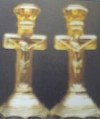Carnival Glass 101 | home Quick Reference to Carnival Glass Patterns
Crown Crystal
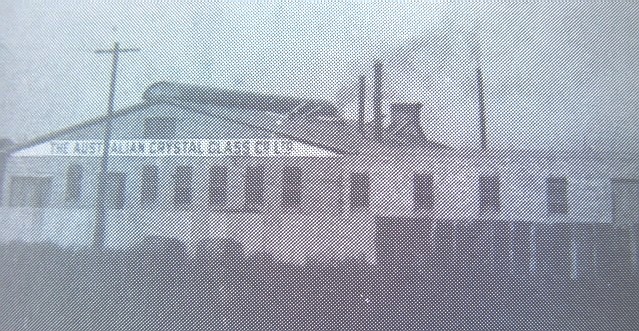
CROWN CRYSTAL GLASS CO. LTD. of Australia
Special Note:
On May 16, 2006, Carl O. Burns noted the fact that an Australian based glass collector posted an ominous message over the eBay Glass Chat Board: Reportedly, a China-based company has purchased numerous examples of old Crown Crystal Glass and are currently producing copies, made in new moulds!
Beware!
This very likely accounts for the fact that some recent discoveries reveal examples which lack the customary Registration # seen on the vintage examples from Crown Crystal Glass.
The following information has been taken from: CARNIVAL GLASS OF AUSTRALIA, copyrighted in 1988, and no longer in print.
As a result of the demand created in America, other manufacturers in Europe and, simultaneously, Australia began to show an interest in the manufacture of this popular iridized glass.
There were a number of companies in Australia that were producing glass wares during the period referred to who were subsequently amalgamated with The Australian Glass Manufacturers Co. Ltd. in 1926 to become Crown Crystal Glass Co. Ltd. These companies were:
1. The Balmain Glass Works, located at Margaret Street, Rozelle, which probably operated from 1919 to 1926, when the plant closed and transferred to the Crystal Glass Works in Wyndham St., Alexandria. Manufacture was from a circular pot furnace, coal fired. It appears that the items produced were mainly for government railways, i.e. water bottles and carriage globes.
2. The Crown Glass Works. Situated in Euston Rd, Alexandria. It is thought that this plant was originally known as the Alexandria Bottle Works and operated by Mr. Joe Worrall, a former employee of Australian Glass.
3. The Crystal Glass Works. Situated at Wyndham St., Waterloo - also known as The Australian Crystal Glass Co. Ltd. (see photo 1921). Commencing date is thought to be 1919 and the production of hot pressed glass tapered off in 1926, finally ceasing when all hands were transferred to Crown Crystal Glass Co. Ltd.
4. The Zetland Glass Works. Situated at Bourke St., Waterloo. Starting date is unknown, but again in 1926 was untied with the former companies to become Crown Crystal Glass Co.
Whilst it is a matter of record that Crystal Glass Co. first registered a design in 1923, obviously to prevent other companies from copying, information supplied by a former employee indicates that production of iridescent glass commenced in 1919 at Crystal Glass Works. It is like that other companies also produced iridescent wares prior to amalgamation in 1926.
Two basic colours were made, the first using Flint (clear) glass which was sprayed at the glory hole to produce a wide range of marigold colours from pale pastels to a deep, rich, golden hue. The second using a range from dark purple to fiery amethyst base glass, again sprayed with chemical oxides, to produce the dark iridescent effect.
Occasionally marigold pieces are seen having an aqua colour base and a possible explanation could be that many bottles, complete with metal tops were fed into the furnace for re-cycling. When melted, these tops went to the bottom of the pot and gave the molten glass an aqua hue so that the latter production from the Melt, produced this colour.
Toward the end of production, as the quality of the Melt deteriorated, causing bubbles in the glass, a few pieces of the regular flint glass production were iridized to hide these bubbles and make the article saleable. Therefore isolated examples can be found with iridescence.
Former employees confirm that the mixing and application of the iridescent producing chemicals was not controlled accurately and hence we have this wide range of shades or colouring, particularly in marigold.
Manufacturing Methods
There appears to be two distinct methods of handling the hot glass from the mould to allow further treatment, such as edge ruffling and iridizing.
The usual practice was to have a split mould and, when opened, the glass was gripped with a pronged pontil onto a collar base.
An unusual feature of Australian glass manufacture is the early one-piece moulds without collar base for which a cup-like punty was used. After all operations were completed this punty was broken off, leaving a chipped and ragged base which was then ground, often leaving traces of chipping on the base. Due to the cup-type of punty the inside of the base was rarely iridized.
With regard to the technical difference between the iridescent finish of carnival glass and the later luster finishes, the former was achieved by exposing the glass while hot and held on the punty, reheated at the glory hole and then sprayed with metallic compound, often of a toxic nature. The later luster finishes were achieved with metallic resinates applied to the cold glass by spraying or brushing and afterwards firing at a lower temperature than the previous method.
The KIWI design, found in 9” and 5” matching bowls, was the last registered by Crown Crystal Glass Co. Ltd. Reg. No. 44289 was applied for on April 19th, 1926. The Kiwi has never received official recognition as an emblem, although it has been accepted and widely identified with New Zealand. The tree fern or silver fern used to circle the Kiwi in the pattern, has been recognized as New Zealand's national flora emblem.
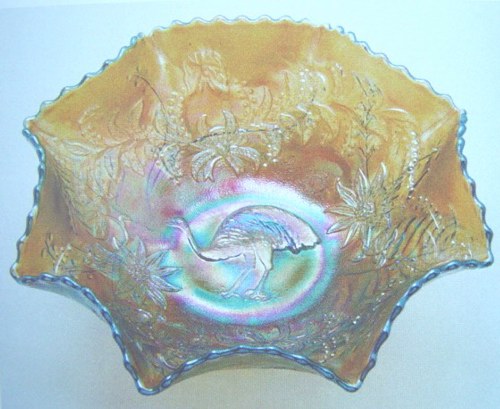
EMU is hard to find in aqua glass. Design is found in a 9 in., & 5 in. bowls,
as well as a large comport the size of a Millersburg Peacock & Urn compote.
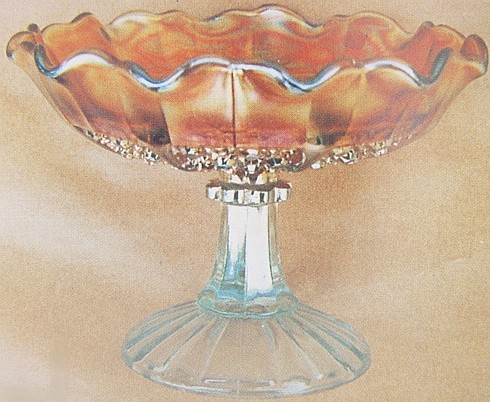
Aqua base glass, when found in comports, creates a delightful appearance.
Some of the exterior designs are elaborately endowed.
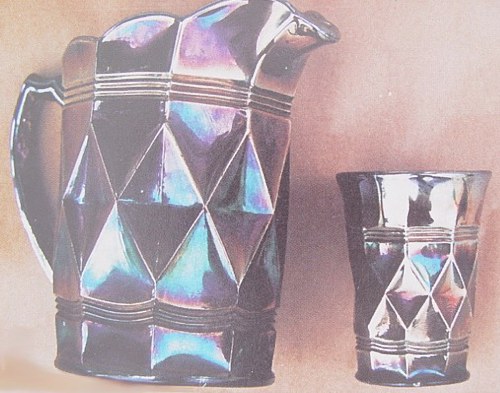
BANDED DIAMONDS
Like the salad bowl in same pattern, glass is thick and heavy.
The bottom has 24 large with 24 smaller raised star pattern.
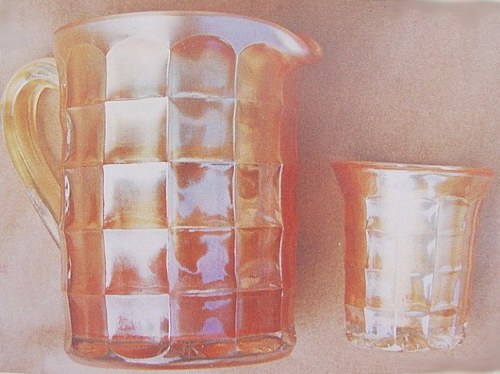
BLOCKS & ARCHES
Sold as a set of Jug and 6 Glasses. Has a 36 point recessed star in bottom.
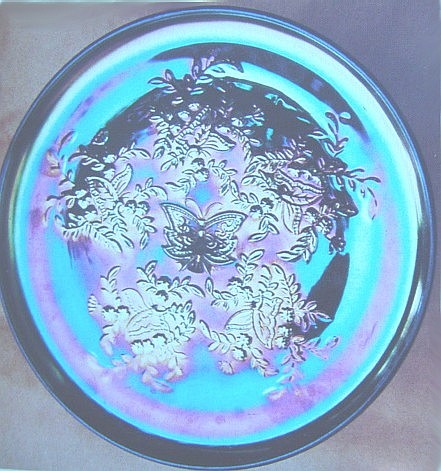
BUTTERFLY BUSH
At least two variations in the floral display and the
type of centre butterfly are noticed in these pieces.
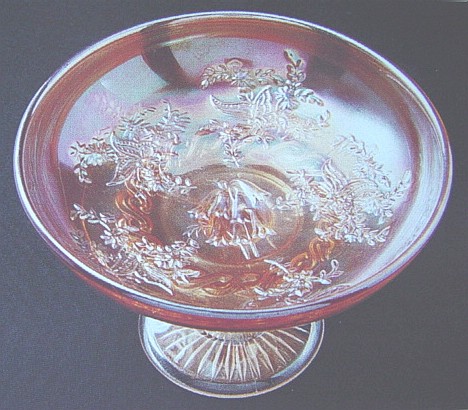
BUTTERFLY BUSH and CHRISTMAS BELLS
Displays the flower found on the Butterfly Bush, so named for attracting butterflys.
The centre flower is the Australian native known as Xmas Bells
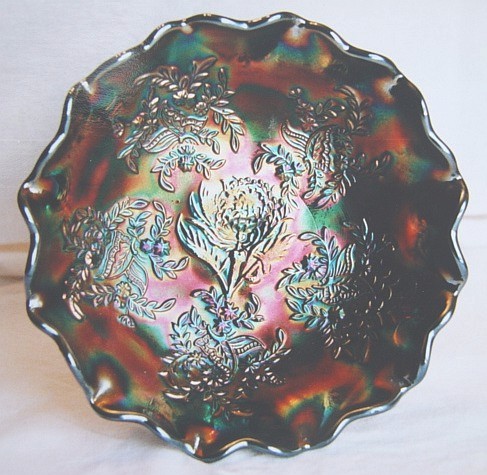
BUTTERFLY BUSH and WARATAH
Design only occurs on this large and desirable comport which is hard to find.
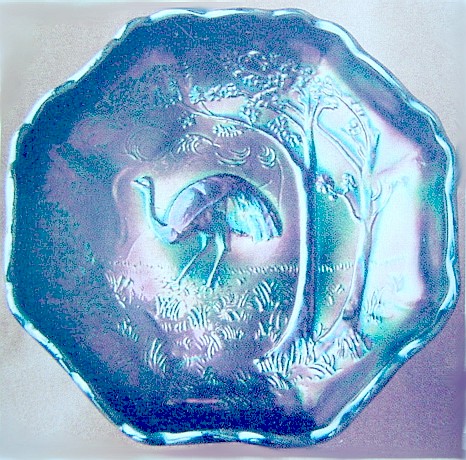
EMU was registered in 1924.
The design was used on comports and a salver.
The marigold bowl is occasionally found on aqua-based glass.
9 in. and 5 in. bowls have slight variation in design.
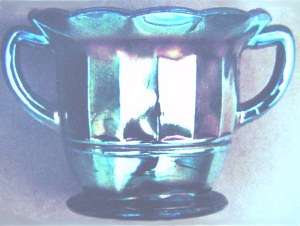 |
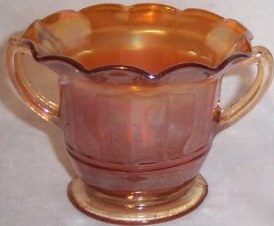 |
PANELLED SUGAR BASIN
9cm high. Found in dark and varying shades of marigold.
Jugs to match this basin have not been seen.
|
Deep marigold PANELLED Sugar
|
BANDED PANELS: This is referred to as black carnival, in a 1985 Wm. Heacock report. It is available in marigold, as well. Seems that a book written by Marjorie Graham, called Australian Glass of the 19th and 20th Century, provides our first major look into the glass industry from Australia, making it possible to properly attribute a considerable number of carnival glass patterns to Crystal Glass, Ltd., of Sydney. This firm registered several bird and animal designs from 1923 to 1926, this seeming to end all our earlier speculation that these popular pieces may have been made in America for exclusive Australian export. The purple carnival from Crystal is very deep and hard to distinguish, even when held up to strong light. The author, Marion Quinton-Baxendale, shows two open sugars in her book, referring to them simply as a “panelled” and “diamond” sugar.
When the Carnival Glass of Australia was printed in 1988 (now out of print), this sugar basin was called simply, “Panelled”, shown on page 66 of that publication. On the opposite page “Diamond” sugar basin is given equal space. That pattern can also be found in marigold shades.
Compiled by Dean & Diane Fry~~~11/04
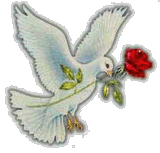 Let not mercy and truth forsake you;
Let not mercy and truth forsake you; 
bind them around your neck,
Write them on the tablet of your heart.
~~~~Proverbs 3:3
back to Carnival Glass 101
Should you care to contact the Frys, their email address is:
Search Carnival Glass 101
Our other sites you may enjoy:
Everything you EVER wanted to know about Indiana Glass
Great Reference for Newer Carnival Glass.
Complete Glassware Catalogs Available to Download
Questions? Comments? Suggestions? Broken Links? Corrections?
Your Friendly Webmaster is here to help!
